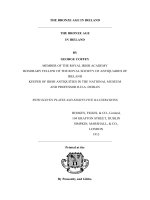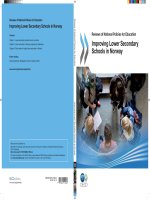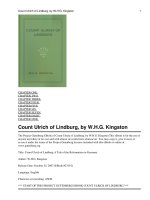Trends in Terrorism pptx
Bạn đang xem bản rút gọn của tài liệu. Xem và tải ngay bản đầy đủ của tài liệu tại đây (327.85 KB, 97 trang )
This PDF document was made available
from www.rand.org as a public service of
the RAND Corporation.
6
Jump down to document
Visit RAND at www.rand.org
Explore RAND Center for Terrorism
Risk Management Policy
View document details
This document and trademark(s) contained herein are protected by law
as indicated in a notice appearing later in this work. This electronic
representation of RAND intellectual property is provided for non-
commercial use only. Permission is required from RAND to reproduce, or
reuse in another form, any of our research documents.
Limited Electronic Distribution Rights
For More Information
CHILD POLICY
CIVIL JUSTICE
EDUCATION
ENERGY AND ENVIRONMENT
HEALTH AND HEALTH CARE
INTERNATIONAL AFFAIRS
NATIONAL SECURITY
POPULATION AND AGING
PUBLIC SAFETY
SCIENCE AND TECHNOLOGY
SUBSTANCE ABUSE
TERRORISM AND
HOMELAND SECURITY
TRANSPORTATION AND
INFRASTRUCTURE
The RAND Corporation is a nonprofit
research organization providing
objective analysis and effective
solutions that address the challenges
facing the public and private sectors
around the world.
CENTER FOR TERRO R I S M
RISK MANAGEMENT P O L I C Y
Purchase this document
Browse Books & Publications
Make a charitable contribution
Support RAND
This product is part of the RAND Corporation monograph series.
RAND monographs present major research findings that address the
challenges facing the public and private sectors. All RAND mono-
graphs undergo rigorous peer review to ensure high standards for
research quality and objectivity.
Peter Chalk, Bruce Hoffman,
Robert Reville, Anna-Britt Kasupski
Trends in Terrorism
Threats to the United States
and the Future of the
Terrorism Risk Insurance Act
The RAND Corporation is a nonprofit research organization providing
objective analysis and effective solutions that address the challenges
facing the public and private sectors around the world. RAND’s
publications do not necessarily reflect the opinions of its research clients
and sponsors.
R
®
is a registered trademark.
© Copyright 2005 RAND Corporation
All rights reserved. No part of this book may be reproduced in any
form by any electronic or mechanical means (including photocopying,
recording, or information storage and retrieval) without permission in
writing from RAND.
Published 2005 by the RAND Corporation
1776 Main Street, P.O. Box 2138, Santa Monica, CA 90407-2138
1200 South Hayes Street, Arlington, VA 22202-5050
201 North Craig Street, Suite 202, Pittsburgh, PA 15213-1516
RAND URL: />To order RAND documents or to obtain additional information, contact
Distribution Services: Telephone: (310) 451-7002;
Fax: (310) 451-6915; Email:
0-8330-3822-2
The research described in this report was conducted by the RAND
Center for Terrorism Risk Management Policy.
iii
The RAND Center for Terrorism Risk
Management Policy (CTRMP)
CTRMP provides research that is needed to inform public and pri-
vate decisionmakers on economic security in the face of the threat of
terrorism. Terrorism risk insurance studies provide the backbone of
data and analysis to inform appropriate choices with respect to the
renewal of the Terrorism Risk Insurance Act of 2002 (TRIA) in
2005. Research on the economics of various liability decisions in-
forms the policy decisions of the U.S. Congress and the opinions of
state and federal judges. Studies of compensation help Congress to
ensure that appropriate compensation is made to the victims of ter-
rorist attacks. Research on security helps to protect critical infrastruc-
ture and to improve collective security in rational and cost-effective
ways.
CTRMP is housed at the RAND Corporation, an international
nonprofit research organization with a reputation for rigorous and
objective analysis and the world’s leading provider of research on ter-
rorism. The center combines three organizations:
• RAND Institute for Civil Justice, which brings a 25-year history
of empirical research on liability and compensation.
• RAND Infrastructure, Safety, and Environment, which con-
ducts research on homeland security and public safety.
• Risk Management Solutions, the world’s leading provider of
models and services for catastrophe risk management.
iv Trends in Terrorism: Threats to the United States and the Future of TRIA
For additional information about the Center for Terrorism Risk
Management Policy, contact:
Robert Reville Debra Knopman
RAND Corporation RAND Corporation
1776 Main Street 1200 South Hayes Street
P.O. Box 2138 Arlington, VA 22202
Santa Monica, CA 90407
(703) 413-1100, Ext. 5667
(310) 393-0411, Ext. 6786
A profile of the CTRMP, abstracts of its publications, and or-
dering information can be found on at />ctrmp/.
v
Center for Terrorism Risk Management Policy
Advisory Board
Jeffrey D. DeBoer (Co-Chair)
President & Chief Executive Officer
Real Estate Roundtable
Peter Lowy
Chief Executive Officer
Westfield Corporation
Jacques Dubois (Co-Chair)
Chairman
Swiss Re America Holding Corporation
James Macdonald
Executive Vice President and
Chief Underwriting Officer
ACE USA
Jack D. Armstrong
Assistant Vice President and
Senior Regulatory Counsel
Liberty Mutual Insurance Company
Kathleen Nelson
Managing Director/Group Leader
TIAA-CREF
Immediate Past Chair, International
Council of Shopping Centers (ICSC)
Kim M. Brunner, Esq.
Senior Vice President and
General Counsel
State Farm Insurance
Art Raschbaum
General Director, Corporate Risk
Management and Insurance
General Motors Corporation
Andrew Coburn
Director of Terrorism Research
Risk Management Solutions, Inc.
Hemant Shah
President and Chief Executive Officer
Risk Management Solutions, Inc.
Kenneth R. Feinberg, Esq.
Managing Partner and Founder
The Feinberg Group, LLP
Cosette R. Simon
Vice President
Swiss Re Life & Health America Inc.
John Gorte
Executive Vice President
Dorinco/Dow Chemical
Steven A. Wechsler
President and Chief Executive Officer
National Association of Real Estate
Investment Trusts
Ken Jenkins
Senior Vice President
Corporate Underwriting/Risk
Management
American Reinsurance
vii
Preface
Following the 9/11 terrorist attacks, concerns about the insurance
industry’s ability to provide coverage against the risk of terrorism led
Congress to pass TRIA. The act requires insurers to offer commercial
insurance that will pay on claims that occur from a terrorist attack,
and for losses on the scale of 9/11, TRIA provides a “backstop” in the
form of free reinsurance. TRIA’s impending “sunset”—on December
31, 2005—presents the opportunity to examine whether the structure
and style of government involvement, and the terrorism insurance
market that it has created, provide appropriate financial protection
against the current threat of terrorism. In other words, how does the
architecture of TRIA align with the underlying terrorism risk?
This book examines current and future trends in terrorism. The
focus of the analysis is on developments that have relevance for ter-
rorist attacks taking place within the borders of the continental
United States and the extent to which they are addressed (or not) by
the TRIA framework. This book should be of interest to federal and
state policymakers, insurers, commercial policyholders, and others
who have a stake in ensuring the economic security of the United
States in the face of the terrorist threat.
This is one of a series of reports that the RAND Center for Ter-
rorism Risk Management Policy is planning to publish to inform
policymakers on terrorism insurance, compensation, and liability.
The CTRMP is funded through pooled contributions from corpora-
tions, foundations, and trade organizations.
ix
Contents
The RAND Center for Terrorism Risk Management Policy
(CTRMP)
iii
Center for Terrorism Risk Management Policy Advisory Board
v
Preface
vii
Summary
xiii
Acknowledgments
xix
CHAPTER ONE
Introduction 1
Background
1
Objective
3
Organization of This Book
3
CHAPTER TWO
The Architecture of TRIA and an Overview of Terrorism Insurance
Since 9/11
5
CHAPTER THREE
Al Qaeda and Imported Terrorist Threats to the United States
Post-9/11
11
What Is the Context for the Evolving Threat?
11
Given This Context, What Does It Suggest for the Nature of Future
Attacks?
15
A Continuing Interest in Hard Targets, but an Increased Focus on
Soft, Civilian-Centric Venues
16
x Trends in Terrorism: Threats to the United States and the Future of TRIA
An Ongoing Emphasis on Economic Attacks 21
Continued Reliance on Suicide Strikes
26
A Desire to Use CBRN Weapons, but Little Ability to Execute
Large-Scale Unconventional Attacks
31
CHAPTER FOUR
Homegrown Terrorist Threats to the United States 39
What Is the Context for the Evolving Threat?
39
Given This Context, What Does It Suggest for the Nature of
Future Attacks?
41
Anarchism
41
The Far Right
43
Radical Environmentalism
47
Implications for Public Policy on Insurance
52
CHAPTER FIVE
Conclusions 55
Key Lessons Learned
55
Conventional Attacks by Foreign Terrorists Against Commercial
Targets Remain a Significant Risk in the United States
55
Several Trends Have Converged to Shift Risks from the
Public Sector Toward Private-Sector Assets Typically
Covered by Insurance
56
TRIA Has Significant Gaps and Is Not Robust to an
Evolving Threat
56
TRIA Does Not Provide Adequate Financial Protection,
Particularly in the Face of Economically Motivated Attacks
57
Policy Implications
57
TRIA’s Sunset, Without Additional Congressional Action,
Will Both Slow Recovery After a Future Attack and Magnify the
Economic Consequences of an Attack, at Least in the
Short Run
58
A Long-Term Solution to Providing Terrorism Insurance in the
United States Must Go Beyond the TRIA Framework
58
The Role of Insurance in Protecting Critical Infrastructure Needs
to Be Examined
59
Contents xi
The Ability of Insurance to Prompt Increased Security in the
Private Sector Is Promising but Requires Further Research
59
Given the Dynamic Nature of the Terrorist Threat, TRIA or
Its Replacement Should Be Designed to Be More Robust to
Changes in the Underlying Risk
60
Bibliography
61
xiii
Summary
Introduction
The Terrorism Risk Insurance Act of 2002 (TRIA) was crafted in the
aftermath of the 9/11 attacks after the insurance industry, stung by
$32 billion in damage claims (by current estimates) and fearing an-
other attack of equal magnitude, began to exclude terrorism coverage
from policies. The legislation requires insurance companies to make
terrorism insurance available to customers and, in return, provides
federal reinsurance (a “backstop”) for losses from terrorist attacks. It
is intended to give insurers time to assess their exposure to terrorism
risk and to consider how to price and underwrite the risk. TRIA is set
to expire at the end of December 2005.
TRIA embodies federal policy that a private insurance market
will provide the foundation of the financial recovery from future ter-
rorist attacks. It also recognizes that since the risk is unfamiliar to the
industry, federal government assistance should, at least in the short
run, be made available to support this market.
In this book, we examine whether this policy and, in particular,
the architecture of TRIA provide robust protection against the threat
of losses from future attacks. By robust, we ask specifically whether
the structure of TRIA is in line with the fundamental qualities of the
risk of terrorism and with likely evolving trends in this threat. The
focus of the analysis is on developments that have relevance for ter-
rorist attacks taking place within the borders of the continental
United States and the extent to which they are addressed (or not) by
the TRIA framework.
xiv Trends in Terrorism: Threats to the United States and the Future of TRIA
What Is The Evolving Threat?
Al Qaeda clearly represents the principal focus of current U.S. con-
cern about transnational terrorism. The network has not only explic-
itly defined its ideological and operational agenda as one directed
against American citizens and property, it has also demonstrated a
proven capability to effectively employ land, air, and sea modalities
against target venues that have ranged from hotels to state-of-the-art
warships. Nothing suggests that the group’s hardcore leadership has
changed its views since December 2003, when bin Laden vowed to
pursue Americans “in their own backyard.”
That said, it is evident that the character of al Qaeda today dif-
fers markedly from what it was when it organized and executed the
suicide attacks of September 11, 2001. The loss of its safe haven in
Afghanistan, combined with the capture and/or elimination of many
of its critical field commanders and functionaries, has forced the
group to reconfigure its operational agenda—away from centrally
controlled strategic assaults executed by an inner core of jihadist ac-
tivists and toward tactically oriented strikes undertaken by affiliated
cells (and sometimes individuals) as and when opportunities arise. In
many ways, the largely monolithic structure that emerged out of Af-
ghanistan in the late 1990s now better correlates to an amorphous
“movement of movements” that is more nebulous, segmented, and
polycentric in character.
Based on these developments, one can postulate four trends that
are likely to become manifest, all of which have relevance for threat
contingencies in the United States:
• A continuing interest in attacking hard targets, but an increased
focus on soft, civilian-centric venues.
• An ongoing emphasis on economic attacks.
• Continued reliance on suicide strikes.
• A desire to use chemical, biological, radiological, and nuclear
(CBRN) weapons but little ability to execute large-scale uncon-
ventional attacks.
Summary xv
In addition to the terrorist threats posed by al Qaeda and both
associated and independent radical jihadists, a growing groundswell
of domestically inspired radicalism has emerged that appears to be
based on the spreading phenomenon of anti-globalization (AG). The
AG movement has had an impact on at least three homegrown enti-
ties—all of which have demonstrated, in varying degrees, an explicit
penchant for violence and civilian-directed action:
• Anarchists, who resonate with the claim that international trade
and commerce are, in fact, a mask designed to hide and covertly
advance U.S. global economic, cultural, and political power.
• Far-right extremists, who reject the loss of individual identity
associated with international movements of people, commodi-
ties, and money; who oppose the concentration of power that
globalization entails; and who argue that globalization is an
American-led conspiracy conducted by and for the benefit of
Jewish capitalists.
• Radical environmentalists, who now routinely denigrate corpo-
rate power and capitalism (and the unrestrained discretionary
spending that they entail) as posing the single greatest threat to
the planet and its life.
A notable common thread in many of the trends is an increased
risk for the private sector. This increase arises from the changes in the
operational environment because of the Global War on Terror; the
hardening of government facilities, which is shifting risk to softer tar-
gets; the rise of extremists motivated by AG and therefore hostile to
corporate power; and the increased focus by al Qaeda on attacks that
yield magnified economic consequences. These changes raise the
stakes for ensuring a properly functioning insurance system that pro-
tects against these risks.
xvi Trends in Terrorism: Threats to the United States and the Future of TRIA
Does TRIA Provide Robust Protection Against These
Threats?
The results of our comparison of these trends in the underlying risk
to the architecture of TRIA and the insurance market shaped by it
has led to two primary conclusions:
• TRIA does not provide adequate financial protection, particularly
in the face of economically motivated attacks. Specifically, take-up
rates for terrorism insurance may be too low, thus escalating the
risk of disruption after future attacks and undermining resil-
ience. As al Qaeda increasingly advertises its interest in attacks
with magnified economic consequences, and as the private sec-
tor becomes more the concerted focus of terrorist attacks, a
growing necessity has emerged to fortify the institutions that
buffer the economic consequences of such an attack. Insurance
provides funds to compensate injured victims and the families of
the deceased, sustain business operations during disruption, and
rebuild damaged and destroyed assets and infrastructure. How-
ever, take-up rates at current low levels (approximately 50 per-
cent) are likely to lead to widespread uninsured losses, which
would slow recovery and magnify the economic consequences.
• TRIA has significant gaps and is not robust to an evolving threat.
Given contemporary trends in terrorism and the current archi-
tecture of TRIA, there remains a real possibility of large unin-
sured losses accruing in the near-to-medium term, which will
significantly impede the recovery from some future attacks. The
most profound risk occurs in the area of CBRN attacks, for
which insurers are not required to offer coverage (except under
workers’ compensation). As a result, such attacks are typically
excluded from most insurance policies. Another significant gap
is the exclusion of domestic attacks; while such attacks are less of
a risk than imported threats, they remain real and increasingly
appear to be focusing on private-sector targets. The exclusion of
domestic attacks is also problematic given the increased “fran-
Summary xvii
chising” of terrorist attacks by al Qaeda to local affiliates and the
added difficulty of attributing attacks to a particular group.
Policy Recommendations
Given these conclusions, this book emphasizes the following two sug-
gestions:
• Instead of allowing TRIA to sunset, particularly in the face of eco-
nomically motivated terrorist attacks, Congress might prefer to con-
sider policy measures that increase the take-up of terrorism insurance
and lower its price. These measures might include offering subsi-
dies for the purchase of terrorism insurance or providing more
risk sharing within the insurance industry in the form of lower
TRIA “deductibles” for insurance companies. With lower indi-
vidual company deductibles, if the entire industry’s backstop
remains the same (the industry “retention” of $15 billion), the
price of terrorism insurance is likely to fall without increasing
costs to taxpayers.
• A long-term solution to providing terrorism insurance in the United
States must address CBRN attacks and attacks by domestic groups.
While the extension of TRIA to domestic attacks is straightfor-
ward, extension to cover CBRN attacks poses significant chal-
lenges for insurance and may be appropriately covered through a
direct government program.
Other suggestions include
• considering mandatory requirements for companies that own or
operate systems vital to the functioning of U.S. critical infra-
structure to carry adequate levels of insurance
• conducting further research on the ability of insurance to
prompt increased security in the private sector
xviii Trends in Terrorism: Threats to the United States and the Future of TRIA
• establishing an oversight board to review TRIA or its successor’s
performance and ensure that it is robust to changes in the un-
derlying risk.
xix
Acknowledgments
We are grateful for the highly useful feedback from those who com-
mented on earlier drafts of this book and helped to refine the analysis
contained therein: Rohan Gunaratna of the Institute for Defense and
Strategic Studies in Singapore; David Brannan, Adjunct Professor
with the Monterey Naval Postgraduate School; Erwann Michel-
Kerjan of the University of Pennsylvania; and Jack Riley of the
RAND Corporation. We also thank Debra Knopman, Mike Wer-
muth, Lloyd Dixon, and Fred Kipperman of RAND for comments
and advice. In addition, a special word of thanks is due to CTRMP
for its generous support, advice, and assistance in facilitating the
completion of this study. From the CTRMP Board, we particularly
acknowledge Hemant Shah, the CEO of Risk Management Solu-
tions, for suggesting the project. Finally, we thank Lisa Sheldone of
the RAND Corporation for her tireless work in expediting and en-
suring thorough quality assurance of the document, Paul Steinberg
for his assistance with communications, and Christina Pitcher for her
patient and excellent editorial assistance. Needless to say, any errors
and omissions in the book are the sole responsibility of the authors.
1
CHAPTER ONE
Introduction
Background
The coordinated terrorist strikes of September 11, 2001, have led to
an enormous response by the U.S. government to increase both
physical and, to a lesser extent, financial security in the face of poten-
tial future attacks. With regard to physical security, an unprecedented
Global War on Terrorism (GWOT) has been set in motion that has
been instrumental in destroying al Qaeda’s territorial base in the
Taliban-controlled areas of Afghanistan; overthrowing the Hussein
regime in Iraq; collapsing entrenched extremist Islamist cells from
Hamburg to Singapore; galvanizing a major reassessment of American
intelligence capabilities; and triggering, in the creation of the De-
partment of Homeland Security, what is arguably the most ambitious
attempt to overhaul the federal government since World War II.
Now, more than at any other time in the past, terrorism has assumed
a central place of importance in American foreign and domestic
policy.
The most prominent federal measure to increase financial secu-
rity was the passage of the Terrorism Risk Insurance Act (TRIA) in
2002, which was intended to stabilize insurance markets reeling from
the enormity of claims made in relation to 9/11 losses. In response to
the size of ensuing payouts from the attacks (the largest from a single
event in history) and concerned that they could not adequately fore-
cast or price terrorist risk and that they would not be able to cover
2 Trends in Terrorism: Threats to the United States and the Future of TRIA
additional strikes on the scale of the 9/11 attacks, many primary in-
surers and reinsurers
1
moved to limit or exclude terrorism coverage
from their policies (see Dixon and Stern, 2004; Kunreuther and
Michel-Kerjan, 2004b; Doherty, Lamm-Tennant, and Starks, 2003;
and Chen, 2004).
2
The result was that terrorism insurance became
either very expensive
3
or unavailable, generating concern within the
wider business community that the lack of coverage would slow
property and commercial development, impede the recovery from
recession, and undermine the general ability of the country to recover
from future attacks (Oxley, 2004; and U.S. GAO, 2004, introduc-
tion).
4
TRIA requires insurance companies to make terrorism risk cov-
erage available to all customers and, in return, guarantees that the
government will provide federal reinsurance (a “backstop”) for any
losses above a certain amount. The act only covers attacks connected
to “foreign” interests and, while not excluding chemical, biological,
radiological, and nuclear (CBRN) attacks, does not specifically obli-
gate insurers to offer this coverage.
5
In broad terms, TRIA encourages
____________
1
Reinsurers provide insurance to insurance companies, allowing insurance companies to
spread their risks better.
2
In December 2004, a federal jury ruled that the strikes on the World Trade Center consti-
tuted two separate attacks, entitling the building’s developer, Larry Silverstein, to collect up
to $2.2 billion; this is more than double the coverage provided by nine insurers at the com-
plex. See Bagli, 2004.
3
Premium rate increases following the 9/11 attacks rose, on average, between 10 and 50
percent. See “P/C Terrorism Insurance Coverage,” 2004, p. 1; and “A Limitless Risk,” 2002.
4
The losses from 9/11 for insurance companies were, of course, in the form of payments to
businesses and individuals affected by the attacks. Including government compensation and
charity as well as insurance, the families of the deceased victims, the injured and ill surviving
victims, businesses, unemployed workers, the City of New York, and others affected by the
attacks received over $40 billion. These resources were used to pay for rebuilding structures,
businesses, and individual lives and were no doubt critical to the recovery of the city and the
country. The largest share of these resources, more than half, was paid by insurance compa-
nies. In this sense, the availability of insurance to pay terrorism losses may have been the
most critical part of the financial security for New Yorkers during 9/11.
5
CBRN exclusions may be disallowed by state regulators, and coverage may follow in some
cases from other requirements, such as the inability to write exclusions on workers’ compen-
sation.
Introduction 3
an insurance market that covers terrorist attacks perpetrated by for-
eign groups that involve the use of conventional weapons, including
catastrophic attacks on the scale of 9/11 and larger.
When the legislation was passed, TRIA was intended to give in-
surers time to assess their exposure to terrorism risk and to consider
how to price and underwrite the risk. TRIA is set to expire at the end
of December 2005.
Objective
This book is intended to review the contemporary terrorist threat to
the continental United States as a means of informing decisions about
the termination, renewal, or reconceptualization of TRIA. While a
literature on the economics of terrorism insurance is developing
(Smetters, 2004; Kunreuther and Michel-Kerjan, 2004b; Lakdawalla
and Zanjani, forthcoming), this book takes the approach of starting
with the underlying risk of terrorism and only then asking whether
the policy of government involvement—and the insurance market
encouraged thereby—is suited to the threat environment as it appears
to be evolving. Specifically, we seek to answer the question, Does the
market for terrorism insurance encouraged by TRIA provide financial
security that aligns with the evolving terrorism threat?
Organization of This Book
In the next chapter, we provide a brief overview of the architecture of
TRIA and of the terrorism insurance market since the 9/11 attacks.
Then, in the next two chapters, we describe the trends with respect to
the dominant terrorist threat—al Qaeda and other foreign
threats—and the trends with respect to the threat of terrorist attacks
from domestic groups. In each chapter, after reviewing the trends, we
describe the implications for terrorism insurance public policy. In the
final chapter, we conclude with lessons learned for the renewal of
TRIA and with policy recommendations.









